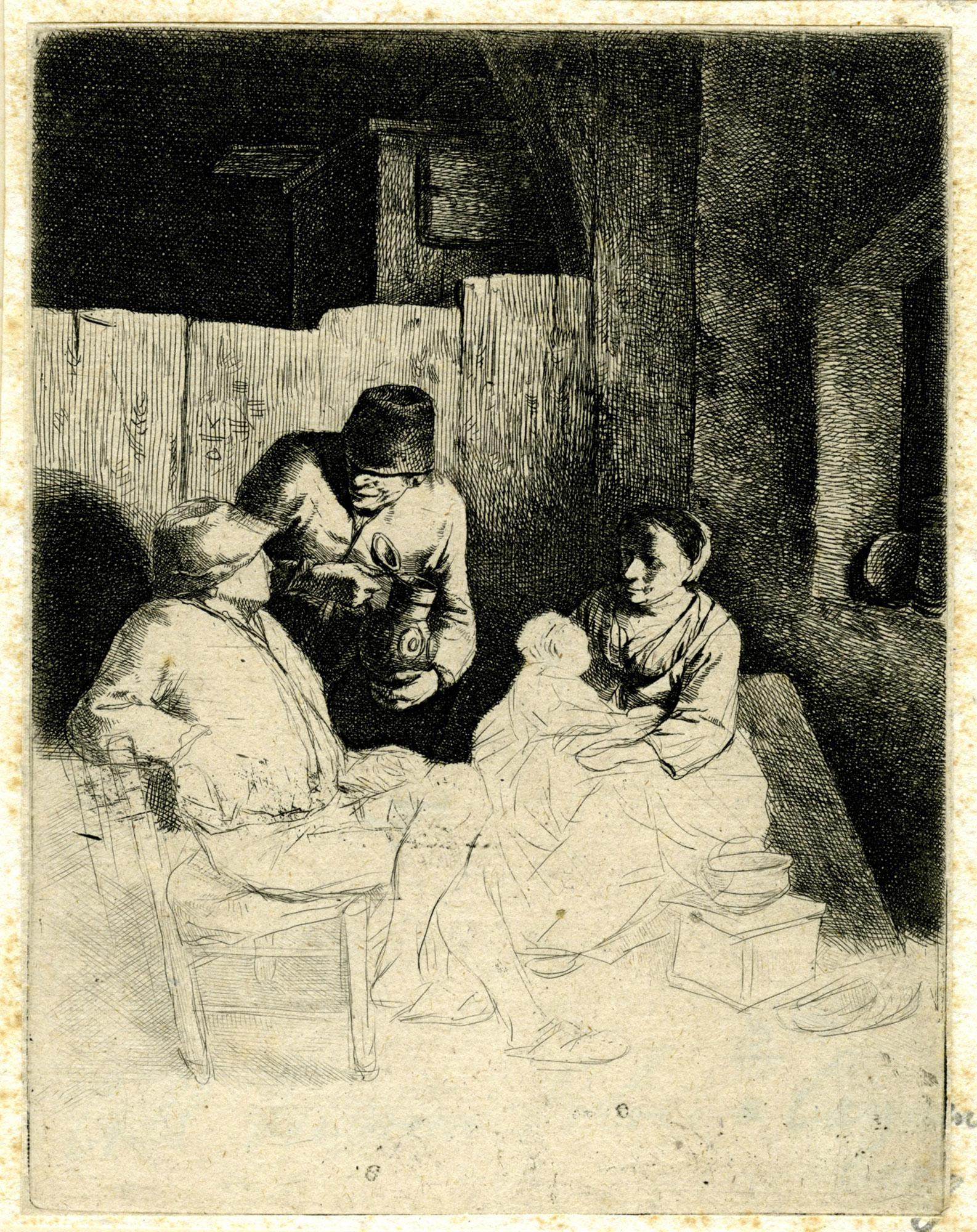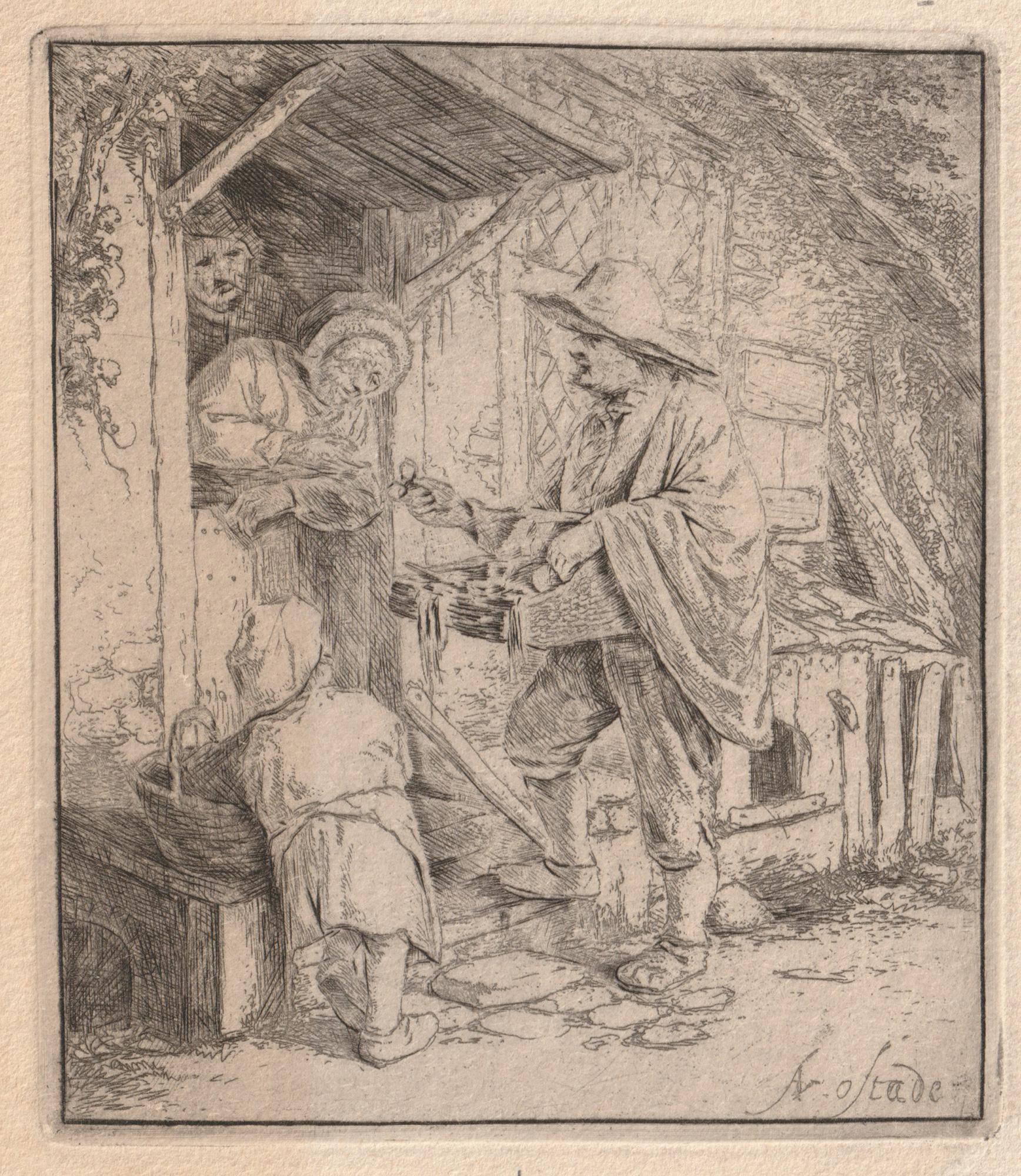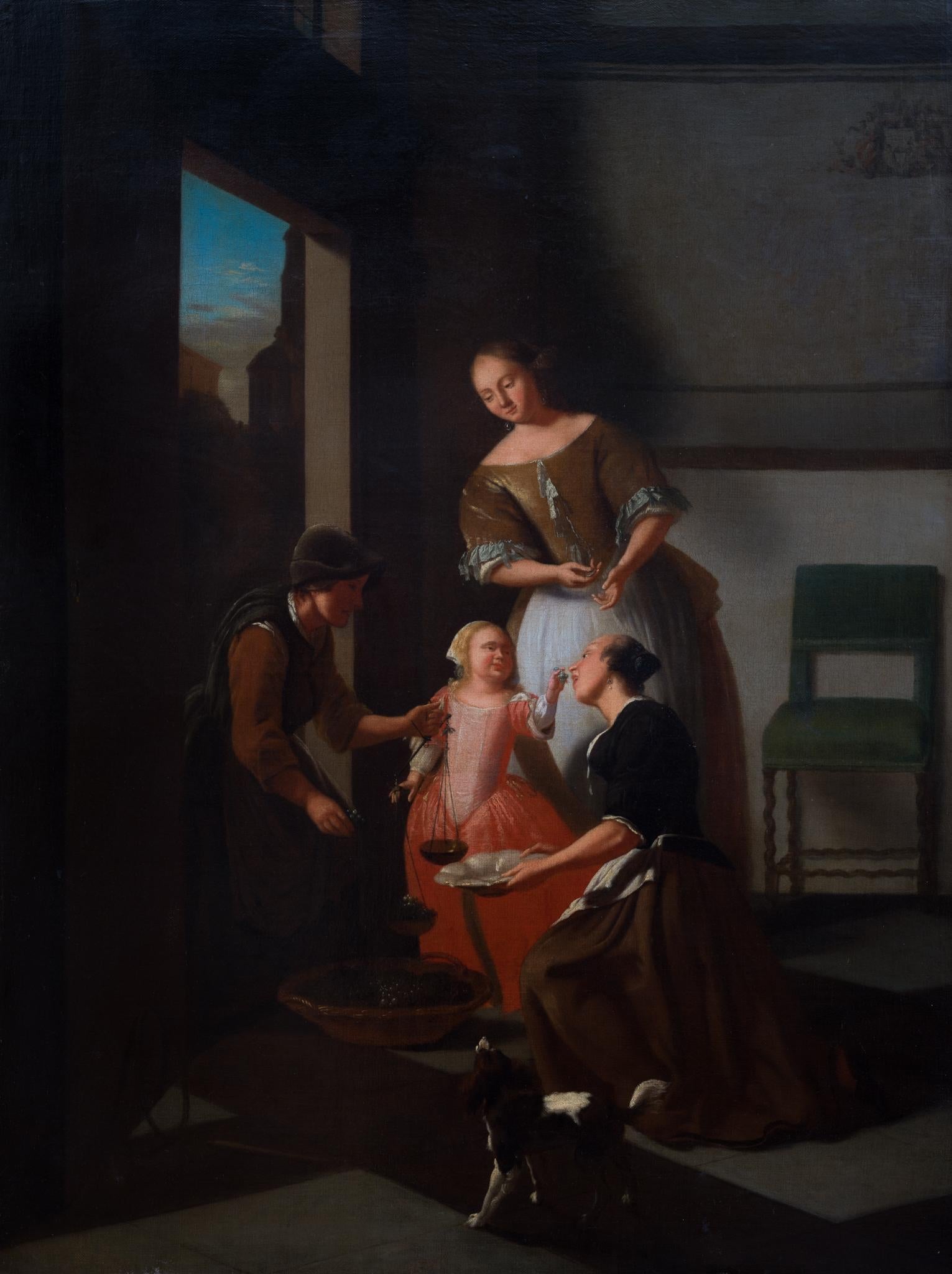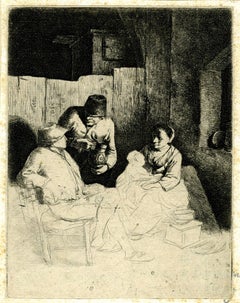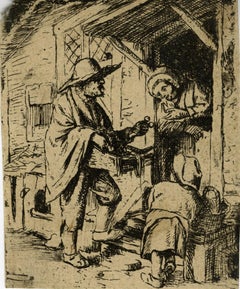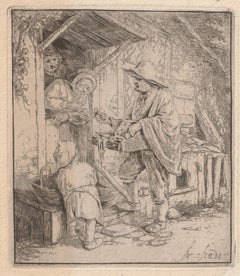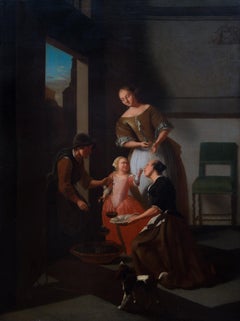Items Similar to The Young Hostess
Want more images or videos?
Request additional images or videos from the seller
1 of 2
Cornelis BegaThe Young Hostess1660
1660
$1,250
£969.41
€1,102.84
CA$1,788.58
A$1,954.17
CHF 1,027.78
MX$23,494.02
NOK 12,940.57
SEK 12,149.49
DKK 8,235.11
About the Item
Cornelis Bega (active 1631/32-64), The Young Hostess, c. 1660-64, etching. Reference: Hollstein, Bartsch 33, third state (of 5). With the address of J. Covens and C Mortier bottom left - before the address was removed (in the fourth state) and the artist’s signature was added (in the fifth state). In excellent condition, printed in black/grey ink on an old laid paper, with a 3/16 inch margin outside the plate mark all around, archival matting.
Provenance: Ex collection Graff (with stamp verso, Lugt 1092a), LRV (with stamp verso, Lugt 1761), an unidentified collector’s stamp verso, and Dr. Karl Herveg (his stamp verso, Lugt 3974).
A very good impression, with the guidelines of the address strongly visible.
Dr. Karl Herweg was a noted collector of 17th Century Dutch prints, especially those of Van Ostade and Bega. Dr. Herweg bought most of his old master prints from CG Boerner in Dusseldorf, where he was advised by legendary connoisseur and scholar-dealer Eduard Trautscholdt whose real passion was the etchings of the Haarlem genre painter-etchers: Cornelis Bega, Adriaen van Ostade, and the latter’s pupil Cornelis Dusart.
In this late stage of Bega’s career he typically grouped his figures tightly in a pyramidal cluster. Here the setting is austere, with various elements extending the middle grouping. The light comes from an undisclosed source in the foreground, and from the open window at the right.
The figures in this scene are characteristic of Bega’s portrayals of Dutch tavern life in the late 17th Century: one old patron caresses the barmaid as the other – his left foot seemingly placed between the feet of the girl - chews on a bone.
- Creator:Cornelis Bega (1631 - 1664, Dutch)
- Creation Year:1660
- Medium:
- Movement & Style:
- Period:1660-1669
- Condition:
- Gallery Location:New York, NY
- Reference Number:1stDibs: LU51531730833
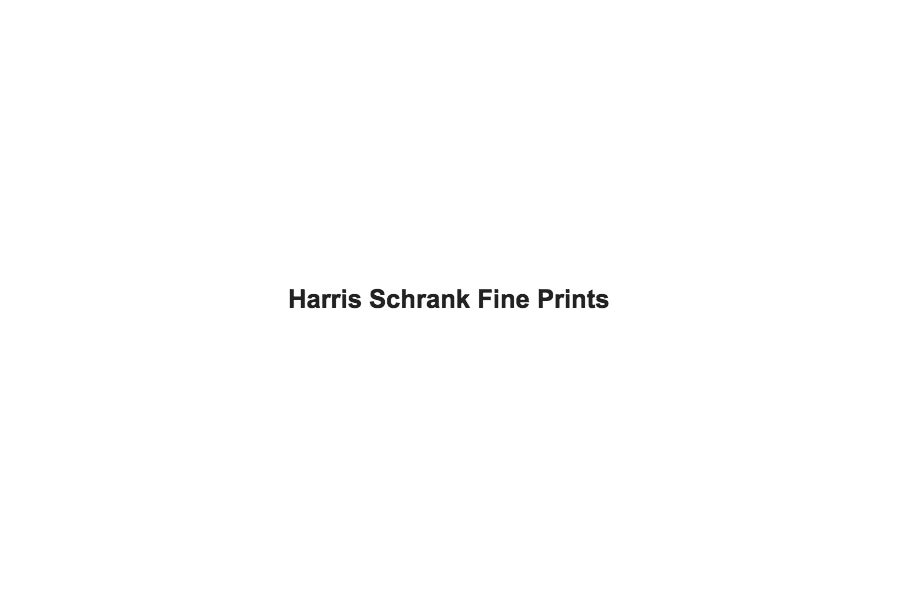
About the Seller
4.9
Recognized Seller
These prestigious sellers are industry leaders and represent the highest echelon for item quality and design.
Established in 2000
1stDibs seller since 2016
107 sales on 1stDibs
Typical response time: 6 hours
Associations
International Fine Print Dealers Association
- ShippingRetrieving quote...Shipping from: New York, NY
- Return Policy
Authenticity Guarantee
In the unlikely event there’s an issue with an item’s authenticity, contact us within 1 year for a full refund. DetailsMoney-Back Guarantee
If your item is not as described, is damaged in transit, or does not arrive, contact us within 7 days for a full refund. Details24-Hour Cancellation
You have a 24-hour grace period in which to reconsider your purchase, with no questions asked.Vetted Professional Sellers
Our world-class sellers must adhere to strict standards for service and quality, maintaining the integrity of our listings.Price-Match Guarantee
If you find that a seller listed the same item for a lower price elsewhere, we’ll match it.Trusted Global Delivery
Our best-in-class carrier network provides specialized shipping options worldwide, including custom delivery.More From This Seller
View AllThe Mother Seated in an Inn
By Cornelis Bega
Located in New York, NY
Cornelis Bega (1631/2-1664), The Mother Seated in an Inn, etching, circa 1660-64. Reference: Hollstein 31, a later impression, second state (of 2). In good condition, trimmed outside...
Category
1660s Old Masters Figurative Prints
Materials
Etching
A Drunken Night Cap
By Jan van der Bruggen
Located in New York, NY
(After) JAN VAN DER BRUGGEN (Brussels c1649 1690 Paris), A Drunken Night Cap, Wine is a Mocker, mezzotint, c. 1720, with artist's name Mieris lower left in t...
Category
1720s Old Masters Figurative Prints
Materials
Mezzotint
Sortie de Theatre a Londres
By Jean-Emile Laboureur
Located in New York, NY
Jean-Emile Laboureur (1877-1943), Sortie de Theatre a Londres, etching and drypoint, 1911, signed in pencil lower left [also signed and dated in the plate upper right]. Reference: Laboureur 104, third state (of 3). Published for La Societe des amis de l’eau-forte, with the blindstamp with the inscription: Circle Librairie Estampes. From an edition in the third state of 109; there were also 5 impressions of the first state and five of the second state. In excellent condition, the full sheet with deckle edges bottom and sides, 6 3/4 x 14; a remarque lower left 2 x 3 1/2, the sheet 12 3/4 x 19 3/4 inches.
Provenance: unknown collector’s mark verso (GOE in oval)
A fine rich impression, printed in dark brown ink on cream laid paper with the Arches watermark.
The small remarque lower left is actually another print printed on a separate plate; it shows a man running after a London horse...
Category
1910s Naturalistic Figurative Prints
Materials
Drypoint
Putting on the Coat (front)
By Isabel Bishop
Located in New York, NY
Isabel Bishop (1902-1988), Putting on the Coat, etching, 1943, signed in pencil lower right and titled (Putting on Coat (front)) lower left margins. Reference: Teller 31. In excellen...
Category
1940s American Realist Figurative Prints
Materials
Etching
Two Fools (or Fool and Foolish Woman)
By Hans Sebald Beham
Located in New York, NY
Hans Sebald Beham (1500-1550), an engraving after Beham’s Two Fools (or Fool and Foolish Woman), engraving, c 1540, a copy or impression in reverse of Pauli 215, Bartsch 213, the cop...
Category
16th Century Old Masters Figurative Prints
Materials
Engraving
The Bohemians
By Jacques Callot
Located in New York, NY
Jacques Callot (1592-1635), The Bohemians, the set of four etchings touched with burin, 1621. Reference: Lieure 374 (second state of four); Lieure 375-77 (second state of two). In ve...
Category
1620s Old Masters Figurative Prints
Materials
Etching
You May Also Like
The Mother Seated in an Inn
By Cornelis Bega
Located in Middletown, NY
Etching on cream laid paper with an indiscernible horizontal watermark, 6 1/8 x 4 11/16 inches (154 x 120 mm). Thread margins. The first state (of two), before the additional work on...
Category
17th Century Old Masters Figurative Prints
Materials
Handmade Paper, Laid Paper, Etching
The Spectacle Seller by David Deuchar after Ostade
By Adriaen van Ostade
Located in Middletown, NY
Deuchar, David (after van Ostade). The Spectacle Seller. 1800. Etching on light cream laid paper, 3 3/4 x 3 inches (93 x 75 mm), trimmed at the platemark. Light skinning and some sur...
Category
19th Century Old Masters Portrait Prints
Materials
Etching
The Spectacle Seller
By Adriaen Jansz van Ostade
Located in Middletown, NY
Etching and drypoint on cream laid paper, 4 x 3 3/8 inches (102 x 86 mm), 1/4 inch margins. Signed in the plate, lower left corner. The 3rd state (of 6), after the rounding of the pl...
Category
Mid-17th Century Old Masters Figurative Prints
Materials
Drypoint, Laid Paper, Etching
The Grape Seller - Workshop of Jacob Ochtervelt
Located in Stockholm, SE
Jacob Ochtervelt (Workshop)
The Grape Seller
oil on canvas
unframed: 80.7 x 61 cm.; 31 ¾ x 24 in.
framed: 109.5 x 89 cm.; 43 1/8 x 35 in.
Essay:
This captivating piece, originating from the studio of the revered Dutch artist Jacob Ochtervelt, mirrors the composition of a signed and dated 1669 canvas by Ochtervelt that is presently housed in the Hermitage museum. Its subject, "The Grape Seller" immerses us in a typical 17th-century interior, replete with characters from various strata of society.
At the center, a fruit vendor is depicted bending over to weigh grapes for the buyer. A child hands some of the grapes to her mother to taste, their attentive maid standing by. The backdrop showcases typical Ochtervelt details: a hint of the city visible through the doorway, light filtering in through an overhead window, and a playful dog at their side.
The exquisite quality of the piece is evident in the minutiae, such as the intricate detailing of the mother's earring, which in reality spans only a few millimeters yet boasts impressive attention to detail. Initially, Sotheby's considered this work to be an autograph piece by Ochtervelt. But due to some uncertainty, it was auctioned as Workshop of Jacob Ochtervelt. On the other hand, the esteemed Cabinet Turquin in Paris leans toward attributing the piece directly to Jacob Ochtervelt himself.
The painting is framed in an authentic period frame, which has been delicately restored by Stockholm's Förgyllning och Bildhuggeri. The frame retains its age-old patina and, while in used condition, has minor imperfections adding to its charm.
Another interesting thing worth to mention is the painting's provenance. It was once owned by the 1st Viscount Rothermere (1868-1940), the founder of the Daily Mail and Daily Mirror...
Category
17th Century Old Masters Interior Paintings
Materials
Canvas, Oil
Scène de Bistrot - Unknow Artist After Adrian Van Ostade - 18th Century
Located in Roma, IT
Image dimensions: 15 x 12 cm.
Scène de bistrot is a black and white etching with burin interventions on paper realized by an anonymous artist, after the Flemish artist Adrian Van Ostade...
Category
Early 18th Century Old Masters Figurative Prints
Materials
Etching
Kitchen Scene - 18th Century Oil on Panel
By Jan Baptist Lambrechts
Located in Stockholm, SE
A Kitchen Scene by Jan Baptist Lambrechts (Antwerp, 1680–1731)
The painting depicts a lively kitchen interior where a man, wearing a hat, raises a glass of red wine in a toast toward...
Category
Early 18th Century Flemish School Figurative Paintings
Materials
Oil, Wood Panel
$2,452 Sale Price
35% Off
Free Shipping
More Ways To Browse
Dutch 17th Century Print
Keith Haring Pyramid
Keith Haring Retrospect
Kim Jong Un
Kim Tschang Yeul
Klimt Embrace
L Jambor
Last Supper Lithograph
Le Joueur De Flute
Lech Poster
Leonda Finke
Leonor Fini Sphinx
Leroy Neiman Artist Proof
Leroy Neiman Cafe
Leroy Neiman Football
Leroy Neiman Frank Sinatra Prints
Leroy Neiman Frank Sinatra
Leroy Neiman Sailing
